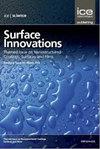Surface characterization and antibacterial efficiency of TiO2 nanotubes on Ti15Mo alloy
IF 2.7
4区 材料科学
Q3 CHEMISTRY, PHYSICAL
引用次数: 0
Abstract
The aim of this work is to investigate wettability and antibacterial properties of the well-ordered TiO2 nanotube (TNTs) surfaces on new generation Ti15Mo alloys for dental and orthopedic implant applications. Thus, the well-ordered TNTs and flat oxide surfaces were fabricated at various potentials such as 20 V, 40 V and 60 V on Ti15Mo alloy by anodic oxidation (AO) technique. Uniform elemental distributions were obtained across all surfaces. In particular, the nanotube surfaces produced at 60 V showed hydrophilic behavior whereas the flat and nanotube surfaces produced at 20 V and 40 V were hydrophobic, respectively. The in vitro antibacterial activity of all surfaces against Escherichia coli (Gram-negative) and Staphylococcus aureus (Gram-positive) bacteria were investigated in detail. Compared to bare Ti15Mo alloys, the flat and TNTs surfaces indicated antibacterial activity. Furthermore, the antibacterial efficiency of TNTs produced on Ti15Mo alloy improved with increasing AO potential values.Ti15Mo 合金上 TiO2 纳米管的表面特征和抗菌效率
这项研究的目的是调查新一代 Ti15Mo 合金上有序的 TiO2 纳米管(TNTs)表面的润湿性和抗菌性,以用于牙科和整形外科植入物。因此,通过阳极氧化(AO)技术,在 20 V、40 V 和 60 V 等不同电位下在 Ti15Mo 合金上制造出了有序的 TNTs 和平面氧化物表面。所有表面都获得了均匀的元素分布。尤其是在 60 V 电压下产生的纳米管表面具有亲水性,而在 20 V 和 40 V 电压下产生的平面和纳米管表面则分别具有疏水性。详细研究了所有表面对大肠杆菌(革兰氏阴性)和金黄色葡萄球菌(革兰氏阳性)的体外抗菌活性。与裸 Ti15Mo 合金相比,平面和 TNTs 表面具有抗菌活性。此外,Ti15Mo 合金上生成的 TNTs 的抗菌效率随着 AO 电位值的增加而提高。
本文章由计算机程序翻译,如有差异,请以英文原文为准。
求助全文
约1分钟内获得全文
求助全文
来源期刊

Surface Innovations
CHEMISTRY, PHYSICALMATERIALS SCIENCE, COAT-MATERIALS SCIENCE, COATINGS & FILMS
CiteScore
5.80
自引率
22.90%
发文量
66
期刊介绍:
The material innovations on surfaces, combined with understanding and manipulation of physics and chemistry of functional surfaces and coatings, have exploded in the past decade at an incredibly rapid pace.
Superhydrophobicity, superhydrophlicity, self-cleaning, self-healing, anti-fouling, anti-bacterial, etc., have become important fundamental topics of surface science research community driven by curiosity of physics, chemistry, and biology of interaction phenomenon at surfaces and their enormous potential in practical applications. Materials having controlled-functionality surfaces and coatings are important to the manufacturing of new products for environmental control, liquid manipulation, nanotechnological advances, biomedical engineering, pharmacy, biotechnology, and many others, and are part of the most promising technological innovations of the twenty-first century.
 求助内容:
求助内容: 应助结果提醒方式:
应助结果提醒方式:


